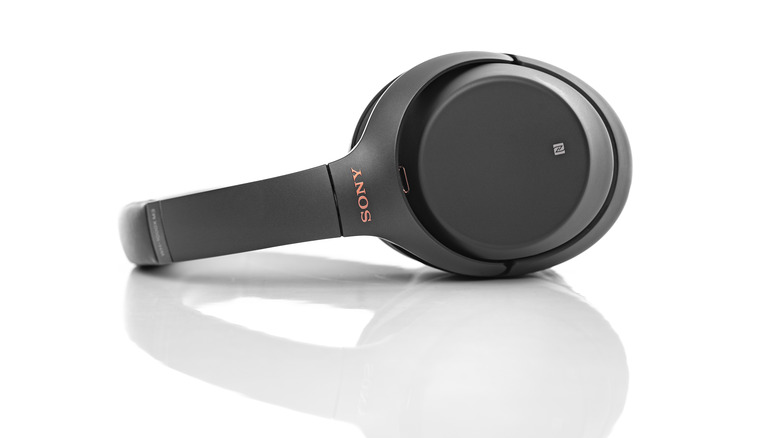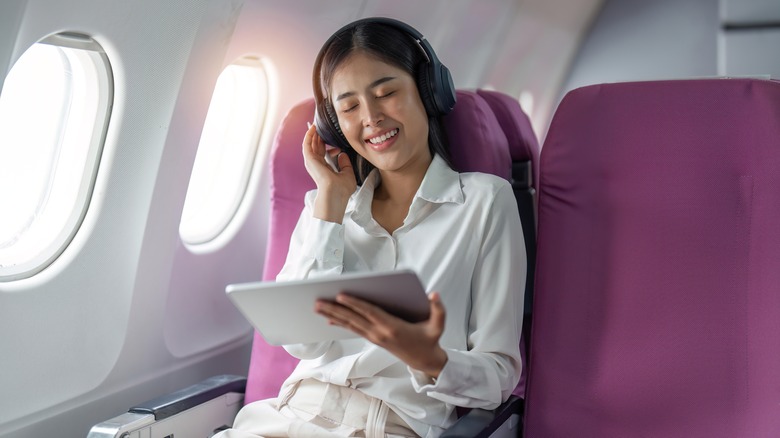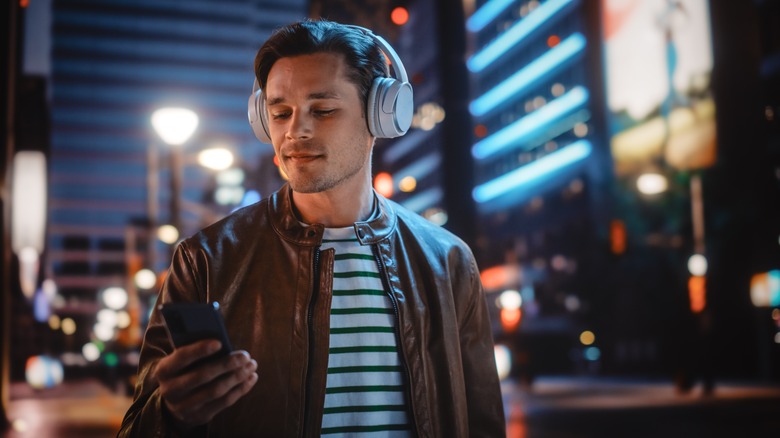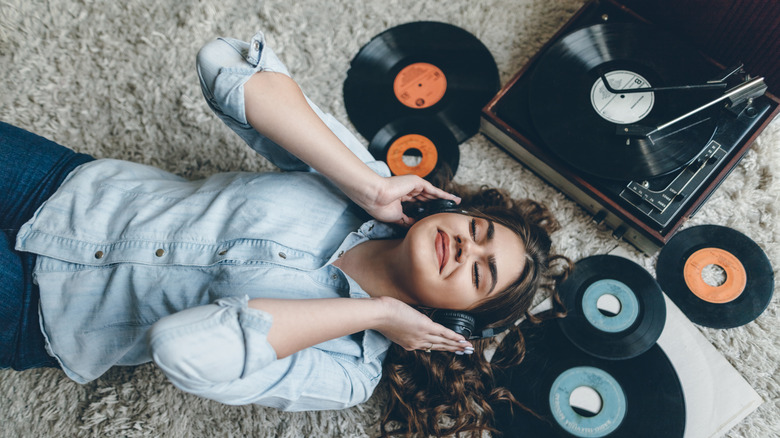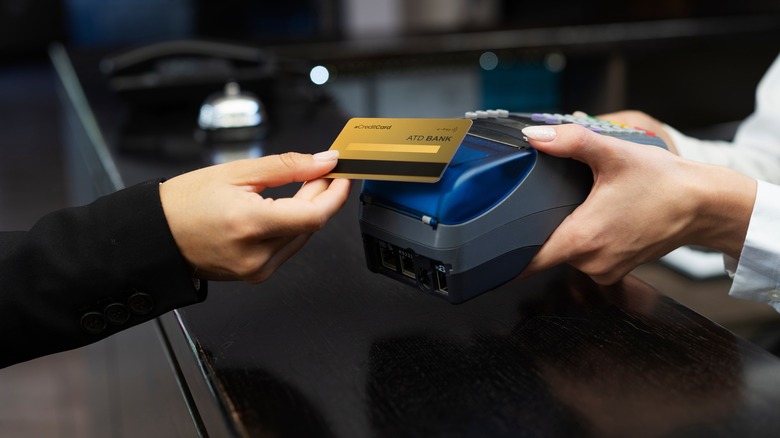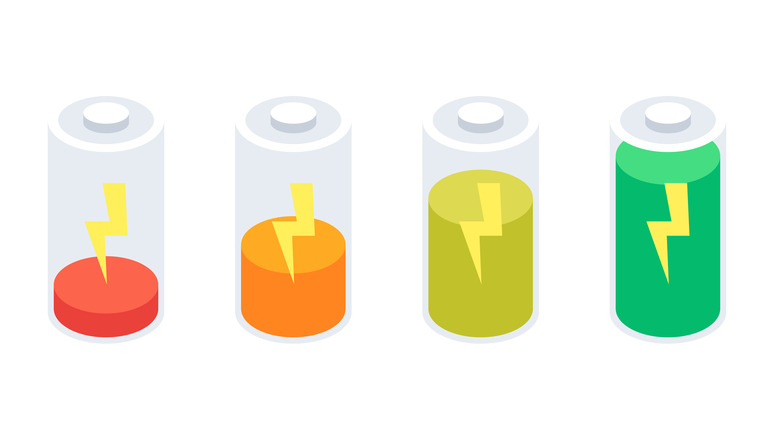10 Myths About Noise Canceling Headphones We Need To Put To Bed
Way back in 1933, Dr. Paul Lueg made a discovery that would someday change the audio industry forever: by playing the opposite frequency of a sound wave, he could effectively cancel it out as if it were never there. That discovery? Noise cancelation. It took until the middle of the century for the tech to see its first implementation, as headphones to protect the hearing of helicopter pilots. Fast forward another half-century to 2006 and Bose had only just begun to produce noise-canceling headphones for consumers. In the almost 20 years since, noise canceling has become the biggest buzzword in headphone-dom, popping up in everything from the high-price kingfisher Sony WH-1000XM5 to the lowly JBL Tune 660NC. This marketing frenzy has helped spread a useful technology and, as is the case with most advertising, a ton of misinformation.
Don't get us wrong, noise-canceling headphones are a game-changer, and practically a necessity for living in noise-polluted cities. They've come a long way from being just a niche luxury product tucked away in magazine ads. Now, virtually all major headphone manufacturers offer their own spin on it. But before you sink some serious money into a quality pair of noise-canceling cans, know what they can and can't do, and don't let all that marketing jargon mislead you. Let's look at the 10 most pervasive myths about noise-canceling headphones that need to go the way of the dodo.
Noise canceling is all the same
Noise-canceling can get confusing (something marketers love to exploit) because there are two ways to do it: passive noise cancelation and active noise cancelation. Passive noise cancelation simply refers to any device — whether headphones or earplugs — with strong noise-blocking properties. These are headphones with thick cups and a tight seal that block out a large portion of ambient noise just by wearing them, no battery required. While these are technically "noise-canceling" headphones, the more accurate term would be "noise-isolating." Think of items like those earmuffs an aircraft marshaller wears out on the runway, or the squishy foam buds you roll and stuff into your ears at a shooting range.
Active noise cancelation (ANC) goes a step further. It uses a processor and microphones to analyze incoming sound and strip it of any offending frequencies on the fly, usually in Bluetooth headphones. Whereas noise isolation can only dampen ambient sound, ANC can (depending on the situation and frequency of the sound) make it all but disappear. Further, a good pair of ANC headphones usually has fairly good passive noise isolation properties, giving you the best of both worlds. So why is this a distinction worth mentioning? Be wary of retailers that sling around the noise cancelation claim willy-nilly. They may trick you into thinking you're getting ANC, in some cases, when in reality it's just noise isolation. Double-check the product specs before handing over your credit card.
ANC can cancel out any noise
In theory, given the principles of noise cancelation, you could cancel out virtually any sound, provided you had the same — but opposite — frequency. In practice, however, current consumer ANC tech mostly succeeds with sounds within the 50 Hz and 1kHz range. Think of low-pitched sounds like the dull roar of an airplane cabin, the rumble of your car on the freeway, the hum of an A/C unit, or anything with a consistent drone. These lower frequencies are longer and easier for your headphones to line up — and cancel out — within milliseconds. Higher frequencies are a different story. Your headphones could (technically speaking) pull it off, but there'd be lag, leaving things out of phase and causing unpleasant feedback.
Obviously, a lot of sound exists above that 50 kHz threshold, especially human voices. The fundamental frequency range of female voices generally runs from 350 Hz to 3 kHz, and men's from 100 Hz to 900 Hz, with harmonics stretching far higher than that. A lot of common vocal sounds are beyond the capabilities of ANC to remove. So if anyone tells you ANC can wipe out a coworker's bothersome chatter while you're at work, ignore them. ANC will be able to get rid of more distant, muffled voices in the background, but it's not going to erase a water cooler catch-up right next to you. Many other everyday sounds will get through, too. To be clear, though, ANC will always be better than nothing in a noisy place.
ANC is better than passive noise-canceling
ANC may only be effective with lower frequencies, but it still does a wonderful job of trimming down the entire ambient noise spectrum to a more respectable listening level, whether that be a bustling city or a hectic office space. It may not cut out those pesky background conversations, but it will diminish them at the very least. Thus, the logical assumption might be that active noise canceling is better than passive, right? Yet as incredible as the tech is — even in optimal conditions — passive noise canceling will be preferable for many instances.
Take situations where you are subjected to dangerously loud external noises, like air ratchets or a jet engine. You should never wear noise-canceling headphones in place of certified hearing protection. It might be tempting to pop on your Sonys while mowing the lawn or cutting 2x4s with a buzz saw, but that risks permanent hearing damage. ANC is better than nothing at all, sure, but it's not an adequate replacement for devices designed expressly to prevent hearing impairment.
Remember, ANC is best for the lower end of the spectrum. Passive noise canceling cuts down a much wider swath of frequencies from low to high, even if it can't "remove" them in the way ANC does. You may find that passive noise canceling does a better job than ANC in a specific environment (where hearing protection isn't required), so bring along a pair of reusable earplugs for those situations.
ANC protects your hearing
So we've established that ANC should not be used to replace actual hearing protection. That aside, ANC is excellent for protecting your hearing in a general sense. A massive problem these days is that of noise pollution. Our cities and workplaces regularly expose us to sounds above 85 decibels — which, for prolonged periods, can permanently damage our hearing. Aside from using hearing protection for dangerously loud noises (like a jackhammer), ANC headphones are an excellent way to mitigate hearing damage from, say, a noisy office. There is, however, a potential health risk from using too much ANC.
ANC can contribute to something known as "listening loss," a term from David McAlpine of Macquarie University Hearing. Rather than hearing loss that happens from literal damage to your inner ear, listening loss refers to "reprogramming" of the brain's aural processing. ANC subjects you to an unnatural amount of silence, one that could warp how your brain perceives sound stimuli. One study showed that prolonged silence from wearing earplugs — similar, in a sense, to ANC — caused test subjects to acquire tinnitus. Though this condition went away shortly after they axed the earplugs from their routines, it raises concerns for those who use ANC regularly. The takeaway is this: don't overuse ANC. Pop in those AirPods Pro on your commute, but maybe disable ANC if you're binging Netflix in bed.
ANC ruins music quality
If you are familiar with ANC, then you've no doubt been warned that using it muddles the fidelity of your music-listening experience. To be fair to the audiophiles who pound their fists about this point, it is true — though it's not something you should be worried about. Noise-canceling headphones produce "anti-phase," the waveform Dr. Lueg discovered that "cancels" any opposite frequency. The unavoidable consequence is that ANC will distort your music to a small degree since that anti-phase will likely interfere when it clashes with similar frequencies in a song. Long story short, if you want the most accurate sonic experience, you'll want to switch ANC off, but to be frank, purists exaggerate the actual impact this has on the listening experience.
Most people can't tell the difference between a lossless song and a lossy one, and most won't notice a degraded experience listening on Bluetooth headphones compared to wired ones. In a similar sense, the impact of ANC on your audio quality is negligible. This myth also rests on a misunderstanding of how ANC works in principle. ANC treats your music as the "wanted" signal and thus avoids canceling it. Anything "unwanted" (external ambient noise) gets the boot. And at the end of the day, listening with ANC removes sounds that would otherwise spoil a more "pure" listening experience, so one could argue that ANC gives you a superior auditory recreation when in an environment that's on the noisy side.
Good ANC is expensive
ANC might be great, you're thinking, but headphones that include it usually come at a sizeable markup — the best Bluetooth headphones will run you hundreds of dollars. Bose's top-of-the-line QuietComfort Ultra sets you back a cool $430, and Sony's WH-1000XM5 only undercuts it by the price of a good meal. That's been the case for years — Bose's QuietComfort 3 required you to sell your firstborn to afford that $349 price tag way back in 2006. For reference, that's enough to buy you a decent budget Android smartphone and still have some leftovers for earbuds (without even adjusting for inflation). Pricing such as this has created the false impression that ANC is the electronic gadget equivalent of a Rolex.
You can find highly rated noise canceling headphones for under $100 — something that would have been unheard of just a decade ago. ANC has evolved a lot in recent years, and those gains have trickled down to cheaper cans. Make no mistake, the noise canceling in the Sony WH1000-XM5 will be a world away from the JBL Tune 660NC, and you could argue that the price of high-quality ANC headphones is worth preserving your precious hearing from years of noise pollution. Still, don't discount (pun intended) the "cheap" stuff. You'll get a lot of utility out of even the cheapest ANC on a long-haul flight or a bus ride.
ANC is only for noisy environments
We've extolled the virtues of ANC for putting a blanket over a noisy world — despite its limitations — but it's important to realize that it's not just for loud environments. Many people choose to use ANC in places that would generally be considered quiet, such as a library. Particularly those who are neurodivergent. Individuals with ADHD can struggle with sensory overload even in a "quiet" place — a whispered conversation or someone walking past can easily rob their focus. ANC can be a vital tool in situations such as these.
The same goes for those with a low sensory threshold, where a relatively loud noise (say, a librarian setting down a book in a metal cart) can be jarring enough that ANC comes to save the day again. The list of people this technology can help goes on. Even if you're not neurodivergent, ANC can at least prevent sounds from tainting your music listening. Maybe you're in a quiet home with the muffled noise of your neighbor mowing his lawn — not a loud disruption, per se, but enough to intrude on the sanctity of a much-deserved listening session. In a nutshell, ANC secures you the quietest place possible regardless of where you are, rather than forcing you to relocate because an inconsiderate person decided to start making noise.
ANC is only for music
We've talked about ANC making your music-listening cleaner and aiding focus, but these often assume you've got some Bach or Beethoven playing in the background. The reality is ANC works as long as the headphones are connected via Bluetooth to your device. Most headphones offer the option to disable their auto-off function, so you can also use them without a device entirely if you so choose. This effectively turns them into a form of ANC earmuffs for any situation — though we repeat, don't use them as a substitute for hearing protection. Need some peace and quiet in a pinch, but don't want the distraction of music? ANC can help.
Another boon of ANC is improving your call quality. The Sony WH-1000XM5 once more makes a good example of this. It features "four beamforming microphones... calibrated to only pick up your voice, [and an] improved signal-to-noise ratio... to catch every single word." Decent ANC with some good mics prevents your interlocutor from getting an earful of whatever noisy environment you're currently in and lets you enjoy a call in the same relative silence. Sure, voice isolation is a default feature in apps like Discord, or with iPhone's voice isolation in iOS 15 — to give a few examples. But your ANC headphones will give you a crystal-clear conversation regardless of which device or app you're using, making them indispensable if you often go hands-free in loud places.
ANC is a battery hog
ANC does require a hefty slice of the battery pie, that much is true. But this has led to the false impression that ANC guzzles battery and is liable to leave you with a dead pair of headphones when you need them most. These days, battery life on ANC headphones is more or less a non-issue. The Sony WH-1000XM5, our shining example, is rated to give you 30 hours of music with ANC enabled, and 40 when set to off. That's only a 25% decrease in battery, which for a whopping 30 hours of listening time — something you'd likely need a couple of weeks to get through — means you won't lose any sleep over it. Budget headphones are the same or better. The JBL Tune 660NC has up to 44 hours of battery.
It's also important to point out that upcoming advancements in headphones are likely to improve those battery savings. Take the recent xMEMS solid-state driver innovation, which allows for exceptional audio quality while drawing less battery power and being smaller, lighter, and more durable. Battery advancements with solid-state batteries could also ack more juice into a smaller space. AI analog chips may someday make noise cancelation only sip the battery. It's not farfetched to see a future with lighter headphones that sport excellent audio quality, longer-lasting battery life, and some of the best ANC we've ever experienced on the horizon.
We've reached peak ANC
ANC has made huge strides in the past two decades in terms of its efficiency, price, and accessibility, but what hasn't changed is the fact that it's still only effective for noises at 1 kHz or below. We've reached "peak" ANC, as it were, and thus future improvements seem like they will only be marginal. Longtime ANC users have personal experience with this. We're at the point where it only makes financial sense to upgrade your headphones once the battery's shot. Headphone marketing about "new and improved" ANC usually amounts to shaving off an extra half decibel of unwanted noise in a fairly narrow frequency band.
That may be changing soon thanks to AI. AI has been shoehorned into everything, from WhatsApp's Meta AI chatbot to Logitech's AI Prompt Builder mouse button, but ANC may reap truly groundbreaking benefits. Researchers at the University of Washington recently spearheaded a technique called "semantic hearing." Using the same deep-learning algorithms powering all the big AI models, semantic hearing allows users to cancel out a wide variety of environmental sounds — including, potentially, human voices.
More impressive, the system lets users choose which sounds they want to hear. You might, for example, eliminate everything but the cry of your baby in the next room over. It's a proof of concept that's a long way away from shelves and the hands of consumers. But when it comes, ANC may see its biggest-ever upgrade.
